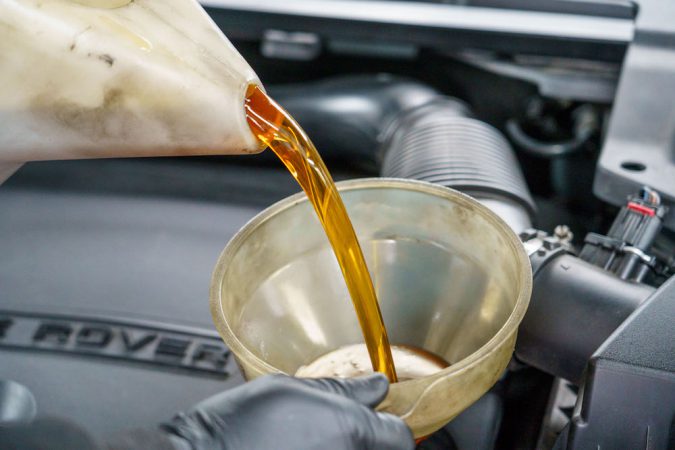Are you planning on flushing your motor oil and you are confused by the numbers 5w30 vs 5w40 and you are thinking of which oil you should pour inside of your engine? If that’s the case, then you are at the right place because there will be a lot to cover when it comes to motor oils.
Using the right motor oil in your engine is key if you want to improve your engine’s performance. Why is this the case? This is the case because every oil works differently. Even the same viscosity oils produced by different manufacturers can operate differently.
The world is so polarized when choosing what is the best oil for your car. Every owner has a different experience and will tell you a different thing. That’s why you need to read a ton of reviews online before you jump into buying motor oil for your vehicle. But even if you narrowed down your choice to the 5w30 vs 5w40, you are on the right track because we are going to cover precisely these two types of oils in this article.
First, we will start from the basics and learn what is motor oil. Then we will learn the difference between mineral and synthetic oils. Then we will learn what is the 5w30 and 5w40 and compare them in a duel of 5w30 vs 5w40. This will greatly help you out with which one to choose. After we are going to answer some common motor oil questions. So, if you want to learn more, follow along till the end.
What Is Motor Oil?
Motor oil or engine oil as many people call it is one of the most important lubricants that allow your engine to work properly.
As the name implies, motor oils were specifically designed to lube the components inside of the engine. These components include the crankshaft bearings, oil rings, and other important bits.
Without engine oil, the car would simply stop working after a few miles. The engine will overheat and irreversible damage will be created on the crankshaft and the cylinder walls. That’s why you need to avoid running your car low on oil.
Any oil is good until the engine is lubricated. Even though some oils work better on some engines like it’s in the case with the 5w30 vs 5w40. But still, if you are low on oil, any oil that is of average thickness will do the job on your car.
In addition to the lubricating ability of the oil. The motor oil also improves heat dissipation. Modern engine oils have a lot of tasks that they perform and this is one of them. They simply remove the heat from the engine and make it work much better.
But this doesn’t mean that the engine could work without coolant. Still, coolant is essential for cooling. But oil also has its role when removing the heat and making sure that everything is at the right operating temperature.
When it comes to temperatures. There are also different viscosities of the motor oils like the 5w30 vs 5w40 that we are going to cover a bit later in the article after we make a difference between the mineral oils and the synthetic oils.
Motor Oil Types
Now let’s discuss the different types of motor oils that are out there. As we know, motor oils are not all the same. They are produced out of different ingredients and it is worth knowing that there is a lot of difference from one to another when it comes to endurance and overall quality.
And in the following chapters, we are going to learn precisely that where we will learn the key differences between these different types of motor oils and then we will see the 5w30 vs 5w40 duel and learn which of them is better when it comes to the type of oil. So, let’s begin.
1. Mineral Oil
The first type of oil that has been with us since forever is the mineral oil type. But what mineral does mean? Mineral means that this type of oil comes from a natural origin.
Mineral oils are used across hundreds of different industries and also in the automotive industry where they are used since the early inception of cars.
The mineral oils are usually a by-product of crude oil. So, instead of throwing these oils away and burning them. Engineers have found ways how to incorporate them in automobiles.
The first cars were driven on mineral oils and they were used as the primary choice of motor oil since recently.
They are a good way for lubrication. But what is bad is that their performance with low temperatures where they don’t shine as well as the longevity of these oils. So, if you go for 5w30 vs 5w40 mineral-based. You will probably get the least when it comes to mileage.
These oils have to be replaced every 3 to 4 thousand miles if you want to keep the health of the engine in check and avoid premature wear and tear. But what are the other types of oils? Let’s see.
2. Semi-Synthetic Motor Oil
Before we dive deeper and cover the synthetic oils. There is a type of oil that is somewhere in between mineral and synthetic motor oils. And that is the semi-synthetic oil.
Semi-synthetic oil is a mixture of synthetic oil as well as mineral oil. This makes this type of oil perform much better than the regular mineral oil and endure quite a bit more than the base mineral oil.
Most of the oils that are sold these days are semi-synthetic. They offer quite a bit of performance as well as a good economy. Meaning that they are cheaper to purchase than regular synthetic oils.
So, going for a 5w30 vs 5w40 semi-synthetic oil is key these days if you want to get good performance for a low buck.
These oils also include a ton of additives that make the oil last for longer and also keep the engine life in check. The average lifespan of a semi-synthetic oil is about 8,000 miles. Even though, they are recommended to be changed at low as 6,000 if you want to keep the life of the engine nice and long.
3. Synthetic Motor Oil
Synthetic motor oils are the best motor oils out there. They are fully produced out of fully synthetic compounds and are not mineral-based.
This greatly affects their endurance and performance which is unmatched by the semi-synthetic oils.
Originally patented by the Germans in WW2 to serve the purpose for their tanks on the eastern front. This was the case because these oils perform excellently at freezing low temperatures. But it was a long time until they were properly introduced in cars. More precisely in the ’70s.
And still, they were in limited use, till recently when they started to be mass-produced. This mass production greatly reduced the price of synthetic motor oil. But still, these oils are quite more expensive than the semi-synthetic and mineral oils by a big margin. But what are you getting if you go for a synthetic 5w30 vs 5w40 oil?
You will get an unmatched performance at below-zero temperatures. This oil will be perfect if you are operating this oil in colder climates.
In addition to this, you will also benefit from the improved engine performance and overall longevity of the engine. These oils are lubricating the components much better and are full of useful additives that increase the engine life by a big margin.
And lastly, they last for quite a bit. Some oils even last for 30,000 miles. Which is insane. But still, it is recommended to change the oil as low as 10,000 to 15,000 miles when you are using these oils. Even though the oil lasts many miles, it is still recommended to be replaced often. But what about the 5w30 vs 5w40? We are going to discuss these two types of oils in the following chapters.
Motor Oil Viscosity
Before you dive deeper into understanding these two types of oils. You need to understand the viscosity of oils. Not all oils are equal and some of them are thicker while some of them are thinner.
Let’s say you are running a diesel engine. In this case, you will greatly benefit by running a thicker oil instead of a thinner one. Since diesel engines are designed to run these types of engine oils.
While if you are running a high-performance vehicle, you will greatly benefit from the use of a thinner oil since the oil pump performs quite a bit better and be able to pump the oil much quicker than the thicker oil. Resulting in better performance.
Another thing is where you live. Some oils are performing much better at low temperatures while some of them are performing better in hotter climates. So, it doesn’t make sense to run a 0w20 oil in Florida where it’s hot. Instead of this, you will benefit more from using something thinner like 5w30 vs 5w40.
But what w stands for? The w stands for winter. The lower the number before the w, the better the oil performs in colder climates. Let’s say there are 0w, 5w, 10w, and 15w. The 0w will deliver you the best performance out there when it comes to cold temps. Even at -40 degrees, these oils perform well.
While the 5w on the other hand will be much thicker when the temps are so low. Meaning that the oil of choice will be the 0w if you are running the car in cold climates. But when temperatures are hotter. The 0w will not perform that well. Except if the number after the w is 30 or 40. Like the 5w30 vs 5w40.
What Is 5w30?
The 5w30 is a motor oil that is intended to be used in lightweight applications. Meaning that it is perfect for cars and light pickup trucks. It is probably the most widely used engine oil at the moment.
But to be clear, the 5w30 is only a viscosity rating and not actual engine oil. If you want to get a specific engine oil you should look for Mobil 1 5w30 or Castrol 5w30. These are two oils that have the same viscosity of 5w30 but in reality, they are quite different.
So, why they are different? They are different because of their structure. One of them let’s say the Mobil 1 could be a fully synthetic oil while the Castrol could be a semi-synthetic.
Even though they have the same viscosity, they actually perform quite differently in the long run. The fully synthetic oil is a much better option than semi-synthetic oil for the reasons that we discussed earlier in this article. But mainly for longevity. Synthetic oils last for long periods of time.
But in this case with the 5w30, the viscosity means that this engine oil performs well at some places where temperatures go moderate below zero. As we know the w stands for winter. In extremely cold environments, the 0w rating is the best in this situation since it doesn’t gelly up when the temperatures get extremely low.
Also the 30 after the 4w means that this oil works really well in warm environments as well. But not the best. It performs the best where temperatures usually reach up to 86 Fahrenheit.
The sweet spot for this engine oil is between -22 Fahrenheit and 86 Fahrenheit.
What Is 5w40?
Now let’s discuss the 5w40. As we learned above, the 5w40 is not a type of oil but a grade of oil. The 5w40 is only telling us the viscosity of the oil and its performance at certain temperatures.
But even though the 5w40 has the same winter viscosity. It is still a thicker oil in normal ambient temperatures. They perform similarly in the winter and they work best at temperatures at -22 Fahrenheit.
If you place both of these oils to leak at average ambient temperatures, you will notice how the 5w30 is much better and looks to be quite thinner than the 5w40. But what makes the difference is the work in the summer months.
The 5w40 is a much better performer in summer because when the temperatures get boiling hot. The 5w40 gets a lot thinner and makes the engine purr like a kitten.
So, if you live in an area that has moderate winters and hot summers. The 5w40 is the right option for you. The 5w40 works best at temperatures that are -22 Fahrenheit and 122 degrees Fahrenheit.
This oil is the way to go if you live in a hotter climate and should be the right choice for you. You can even go a step ahead and get a 10w40 which is an even better performer in hotter climates. Especially if you don’t have winter seasons. But what about the 5w30 vs 5w40? That’s what we are going to cover in the following chapter.
5w30 vs 5w40 Which Is The Way To Go?
We have covered both of the oils above and now it’s time to take a look at which one to choose. Which is the best option for you? That really depends, to be honest. If you are using a regular truck or a car and you live in warmer climates, these engine oils should be one of your top picks.
But still, there are differences when it comes to both of them. They both perform similarly at temperatures at -22 Fahrenheit but as the temperatures rise. The advantage goes for the 5w40.
As the temperatures rise, this oil gets far thinner and really makes the engine feel alive. If the temperatures where you live are nonstop hot like in south Florida, California, Arizona, you will greatly benefit from the 5w40 oil.
But if you live up north, then going for a 5w30 oil will be the right choice because this oil performs also quite well in the colder areas. And if the average winter temperature goes below 22 degrees Fahrenheit. Then going for a 0w20 or 0w30 oil will be an even better option.
You should also check the owner’s manual and read more about the recommended oils for your car. Here you can learn quite a bit more about which one should you choose when it comes to 5w30 vs 5w40. But from my experience, either way, you go you will not make any big difference.
The difference is very small and almost nonexistent. You can try both of them and see with which type of oil your engine works the best. But also make sure that you go for quality oil that was approved for that specific engine you are running. But more on that in the following chapter where we will cover our proposals.
Which Oil Should You Choose? 5W30 VS 5w40?
Now let’s see what are the best oils that you can get for your buck. We will focus primarily on the 5w30 vs 5w40 and we will give our recommendations on both of these oil viscosity ratings for both semi-synthetic as well as synthetic. For you to have a choice for each price point and make your life easier when choosing the right oil for your car. So, let’s get into it.
Semi-Synthetic 5w30 VS 5w40
Semi-synthetic oils are a popular choice for many owners since they both offer better price to performance ratios. They are an excellent deal for your money. So what are our recommendations? Let’s see.
Just a small tip, when you read synthetic blend it means semi-synthetic. That synthetic blend is just a marketing phrase.
- Amazon Basics High Mileage Motor Oil – Synthetic Blend – 5W-30 – 5 Quart
- Valvoline High Mileage with MaxLife Technology SAE 5W-30 Synthetic Blend Motor Oil 5 QT
- Pennzoil Synthetic Blend 5W-30 Motor Oil (5-Quart, Single-Pack)
Fully Synthetic 5w30 VS 5w40
Now let’s see what fully synthetic options are available when it comes to 5w30 vs 5w40. These oils are a bit more expensive but also more durable and will protect your engine better than the regular semi-synthetic engine oils.
- Castrol Edge 5W-40 A3/B4 Advanced Full Synthetic Motor Oil, 5 Quart Jug
- Pennzoil Ultra Platinum Full Synthetic 5W-30 Motor Oil (5-Quart, Single Pack)
- Mobil 1 5W-30 Extended Performance Full Synthetic Motor Oil, 5 qt.
- Liqui Moly 20232 Molygen New Generation 5W40 Motor Oil, 5 l, 1 Pack
When Oil Should Be Changed? 5w30 VS 5w40
Oil changes should be done at specified intervals. These intervals if your car is under warranty are decided by the dealership where you service the vehicle. In this case, you need to service your car whenever they tell you to do if you don’t want to lose your warranty.
If you don’t have a warranty and the vehicle is an older model. Then you can service it whenever you prefer. The recommended oil change intervals are somewhere about 6,000 to 8,000 miles for semi-synthetic oils. While the fully synthetic oils can go a lot more and some of them even reach 20,000-mile intervals. But even if the oil makers claim this on the jug.
The best option would be to flush the oil somewhere between 10,000 to 13,000 miles. Don’t go over the top with the oil changes. Still, they are not that expensive.
What If I Don’t Flush My Oil?
We covered the topic of 5w30 vs 5w40 and we learned quite a bit when it comes to these types of oil viscosity ratings. Now let’s see what will happen if you don’t flush the oil.
If you don’t flush the oil, the engine components will get damaged. The oil with a long time of use will lose its lubricating characteristics. So, the more miles you put on the oil. The more dirty and thick it becomes, ending up damaging the rod bearings as well as the cylinder walls. Which is a bad thing. That’s why flush your oil regularly if you want to avoid possible problems.
Engine Oil Viscosity Grades: Facts You Need to Know
- Engine oil viscosity grades are defined by the Society of Automotive Engineers (SAE) and listed on the oil container.
- Each viscosity grade indicates a specific viscosity characteristic and range.
- Viscosity refers to an oil’s thickness and its resistance to flow.
- A multi-grade oil viscosity grade contains two numbers and a “W,” and the first number represents the oil’s cold weather viscosity grade, while the third number represents the oil’s hot weather viscosity grade.
- 5W-40 oil is thicker than 5W-30 engine oil at warmer temperatures, despite both having the same viscosity grade in cold weather.
- 5W-40 is the suggested oil for most diesel applications, while 5W-30 oil is the recommended oil for many modern gasoline applications.
- To determine the correct engine oil for your car, you can check the information in your owner’s manual or look at the oil fill cap on top of the engine.
- Using the incorrect type of oil for your vehicle can cause engine performance problems and trigger the check engine light, as well as accelerate engine wear and cause internal damage.
- The only time you might consider deviating from the oil the vehicle manufacturer recommends is when your car’s engine already has internal problems.
- Using the correct type of oil recommended by the vehicle manufacturer will keep your engine running better and longer.
Conclusion To 5w30 VS 5w40
In this article, we have covered quite a bit when it comes to engine oil. First, we learned what is engine oil and the engine oil types. As we concluded there are mineral oils, semi-synthetic and synthetic oils.
Then we learned the viscosity and we learned what is the 5w30 vs 5w40 all about. These two are pretty much similar oils. The only difference is that the 5w40 performs quite better in hot environments. That’s why if you want something thinner in the summer the 5w40 is the way to go. Either way, go for the 5w30.
Lastly, we have covered which one to choose and we gave you our recommendations when it comes to engine oils that are listed on Amazon.




